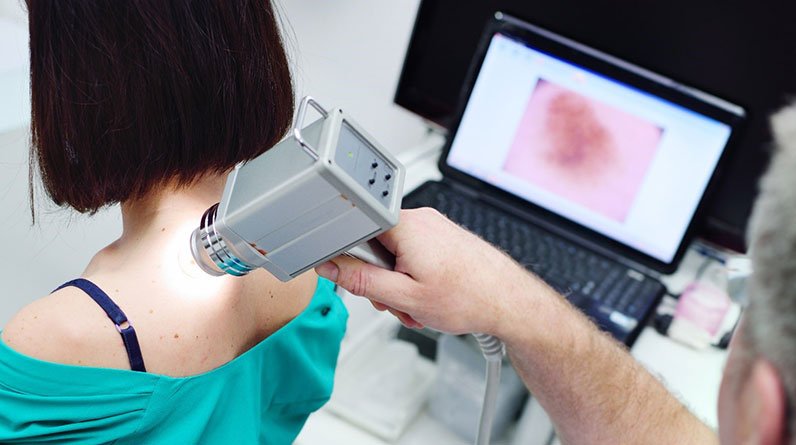
AI for Dermatology and Skin Health
What was once a human-only job that was laborious and intensive and involved manual efforts to characterize, classify, assess, and diagnose medical conditions of dermatology is now assisted greatly by the advent and rapid growth of AI technology.
AI can now aid in the tracking and monitoring phases of skin issues as well as in the diagnostic phases. The use of AI to help dermatologists better manage dermatologic illness is growing, and there is an ongoing effort to improve this connection.
In the following, we’ll discuss some specific skin health conditions and how AI applies to the evaluation and management of these conditions.
Skin Cancer and Melanoma
Skin cancer, particularly melanoma, is a serious and potentially life-threatening condition that requires early detection and intervention for successful treatment.
Over the years, advancements in technology have led to significant improvements in the field of dermatology, with AI emerging as a powerful tool to accurately distinguish between benign skin conditions and malignant melanoma, as well as other types of skin cancers.
AI’s ability to analyze large databanks and recognize subtle patterns has revamped the process that dermatologists use for the evaluation and management of these conditions.
AI’s interpretation skills are impressive and efficient. In addition, machine learning, a subset of AI, plays a pivotal role in training algorithms to become proficient in identifying various types of skin lesions, and the track record has proven at times to be better than expert clinicians.
Ultimately, by analyzing a multitude of images, AI algorithms become adept at identifying combinations of features that are indicative of malignancy, excelling in the recognition of minute patterns, such as irregular borders, color variations, and asymmetry.
Psoriasis and Other Inflammatory Skin Diseases
Inflammatory dermatoses, a group of skin conditions characterized by redness, swelling, and irritation, encompass a range of disorders such as psoriasis, acne, and lichen planus.
These conditions often present complex challenges in diagnosis and management, however, the integration of AI into dermatology has created a new era of accuracy and efficiency in classifying and assessing these inflammatory dermatoses.
Because inflammatory skin conditions are frequently diagnosed based on visual characteristics and patterns, AI, particularly machine learning algorithms, can recognize intricate patterns that can be difficult to discern with the human eye alone.
Monitoring the progression and severity of these inflammatory skin issues is essential for effective management. AI-powered tools offer the capability to track changes over time by analyzing images taken during different stages of the condition.
By quantifying factors such as redness, scaling, and lesion distribution, AI algorithms provide objective measurements that aid dermatologists in assessing treatment efficacy and making necessary adjustments.
AI Applications in Skin Health
In addition to its role in variable skin cancers, AI also has several applications related to ulcer assessments, gene expression profiling, and other pathologies related to skin health.
AI’s potential for automating histological imaging processing is only a fraction of its application in medical assessments overall, however, the following will be some additional insight into this ability.
Ulcer Assessments
AI algorithms analyze vast patient data, including medical history and clinical parameters, to identify individuals at a higher risk of developing diabetic ulcers and pressure ulcers.
By pinpointing potential risk factors and early warning signs, AI gives healthcare providers additional help to intervene proactively, offering preventive measures that can stop the progression of these skin ulcers.
For starters, AI’s image analysis capabilities play a pivotal role in wound monitoring and progress tracking.
Second is its ability to formulate customized treatment plans. By amalgamating patient-specific factors, wound attributes, and historical treatment outcomes, AI algorithms generate personalized strategies that enhance the efficacy of interventions.
Finally, AI’s predictive analytics capabilities offer a glimpse into the future course of diabetic and pressure ulcers. By considering a spectrum of variables and leveraging historical data, AI models can predict the likelihood of a wound healing or deteriorating.
Pathology and Gene Expression
The convergence of AI and pathology has paved the way for new advancements in the analysis of skin tissue images and gene expression profiling.
Histopathology, a cornerstone of dermatology diagnostics, involves the examination of tissue samples under a microscope. AI’s remarkable image analysis capabilities have now opened up novel possibilities for automating and enhancing this critical diagnostic process.
AI’s application significantly speeds up the process. Traditional microscopic examination of tissue sections can be labor-intensive and time-consuming.
AI-driven algorithms, particularly convolutional neural networks (CNNs), excel in recognizing intricate patterns within images. This powerful ability enables AI systems to detect abnormalities, identify cell types, and even pinpoint specific biomarkers with a precision that rivals, and in some cases surpasses, human pathologists.
As AI continues to evolve, its potential to revolutionize pathology and genomic medicine will be an exciting process to watch.
Final Thoughts
AI complements the expertise of pathologists and dermatologists as they move forward in the continued treatment of skin conditions. All certainly welcome the ability to provide more reliable analyses, accurate diagnoses, and treatment recommendations.
As AI applications to skin health continue to advance, it stands poised to redefine the landscape of skin care.
